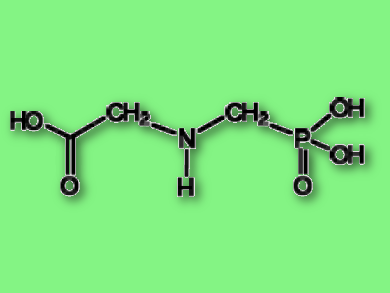Glyphosate (N-(phosphonomethyl)glycine) is the world’s best-selling herbicide. Often sold under the brand name Roundup® (formulation of the isopropylamine salt of glyphosate with a surfactant), the glyphosate-based herbicide is applied to the leaves of plants to kill both broadleaf plants and grasses. It kills them by blocking proteins essential to plant growth. After seeds such as soya, corn, and wheat were genetically engineered to tolerate the chemical, the use of glyphosate skyrocketed.
Glyphosate was synthesized by Henri Martin, Cilag, Switzerland, in 1950. As the molecule showed no pharmaceutical perspective, the work was never published. In 1970, John E. Franz, Monsanto, USA, discovered glyphosate to be an herbicide. It was first registered for use in the U.S. in 1974 and long seen as “a discovery as important for reliable global food production as penicillin for battling disease” [1].
Controversy
Today, there are controversial opinions about glyphosate and its effects on human health. Glyphosate binds tightly to soil. Glyphosate has a zwitterionic structure and consequently shows outstanding water solubility, similar to amino acids. It is found in many rivers, wastewater treatment plants, and rain. Glyphosate contributes significantly to species extinction in the agricultural landscape.
According to the WHO Cancer Research Agency, glyphosate is a probable human carcinogen. It probably affects the body’s endocrine system causing problems in the liver and kidneys. Glyphosate residues are said to last for about one year in food and feed. The BUND (Bund für Umwelt und Naturschutz Deutschland; a German non-governmental organization (NGO)) and Friends of the Earth Europe (FoE) have found glyphosate in the urine of 45 % of 182 people from 18 European countries [2].
The most common surfactant in glyphosate formulations is polyethyloxylated tallowamine (POEA). This and other ingredients were assumed to be inert. However, research indicates apparent synergistic toxic effects with glyphosate [3].
Regulation
In 2016, the authorization for using glyphosate in the EU has expired. After several attempts, the necessary majority was not reached among the EU Member States to allow authorization for further 15 years. The European Commission has extended the authorization temporarily until the end of 2017, while its authorities are deciding whether to renew it or not.
In March, the European Chemicals Agency (ECHA)’s Committee for Risk Assessment (RAC) concluded—after carrying out an extensive evaluation of all the information that was available for the substance—that glyphosate should not be classified as a carcinogen, as a mutagen, or as toxic for reproduction [4]. They classified glyphosate as a substance causing serious eye damage and being toxic to aquatic life with long-lasting effects. ECHA emphasized that it only looks at the hazardous properties of a chemical (its potential to cause harm due to being poisonous, flammable, corrosive, etc.) and not at the risks which may occur once the chemical is used in a product (its possibility of harm in defined circumstances). The latter is done under the Pesticides Regulation. The European Commission now takes ECHA’s recommendation into their final decision, which is scheduled for the end of this year.
According to the BUND and FoE analysis from July 2017, “Glyphosate and cancer: Authorities systematically breach regulations” [5], glyphosate should have been classified as “probably carcinogenic” according to the current EU standards.
References
[1] Stephen B. Powles, Gene amplification delivers glyphosate-resistant weed evolution, Proc. Nat. Acad. Sci. 2010, 107(3), 955–956. https://doi.org/ 10.1073/pnas.0913433107
[2] BUND, FoE, Determination of glyphosate residues in human urine samples from 18 European countries, June 2013.
[3] N. Benachour, G. E. Séralini, Glyphosate formulations induce apoptosis and necrosis in human umbilical, embryonic, and placental cells, Chem Res Toxicol. 2009, 22(1),97–105. https://doi.org/10.1021/tx800218n
[4] ECHA, Glyphosate not classified as a carcinogen by ECHA, March 2017.
[5] Peter Clausing, Glyphosate and cancer: Authorities systematically breach regulations, GLOBAL 2000, Vienna, July 2017.





US and colombian government has used Glyphosate against coca plant crops, but they have killed native trees, animals, rivers and harvests. Glyphosate in Colombia has been a gun to kill nature.